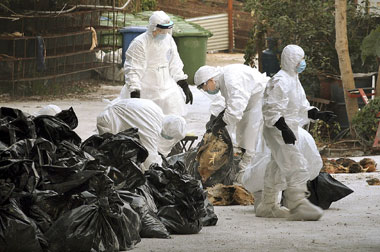Hong Kong health authorities raised the city's avian flu alert level to "serious" yesterday after the H5 virus killed dozens of chickens at a farm, prompting the precautionary slaughter of 80,000 birds.
|

|
|
Health workers pack dead chickens at a farm in Hong Kong on December 9. |
Laboratories in the city were trying to determine the precise identity of the virus. A leading expert said it could turn out to be the highly pathogenic H5N1 strain, which turns up regularly in flocks in Asia, parts of Europe and Africa.
"It's highly likely it's the highly pathogenic H5N1 strain because others don't kill chickens like this. But this has to be confirmed," said virologist Malik Peiris at the University of Hong Kong.
Although H5N1 is mainly a disease among birds, health officials fear it may mutate into a form that spreads easily among people.
If that happens, it could trigger a pandemic and kill millions. Even in its current hard-to-catch form, H5N1 has infected 389 people since 2003, killing 246.
Hong Kong Health Secretary York Chow said the affected farm was in the city's northern Yuen Long District, which reported the unusual deaths of 60 chickens on Monday.
"After a series of tests, we have confirmed this morning that the chickens died from the H5 virus," Chow told reporters yesterday.
Workers clad in masks, white medical suits and black rubber gloves began the mass slaughter of some 80,000 birds at the farm yesterday afternoon.
All chickens within a 3-kilometer radius of the farm are scheduled to be destroyed, along with birds at a wholesale market, Chow said.
Chicken farms in Hong Kong observe strict biosecurity measures to prevent disease and cross-infection between species, and chickens are vaccinated against the H5N1 virus. It was not immediately known how the birds became infected.
"It could be injection (of the virus) from wild birds. These (incidences) increase in winter. But it is not the only possibility," Peiris said.
The scenes were reminiscent of previous culls in 1997 and 2001, when the H5N1 virus prompted the slaughter of more than 1 million birds each time. In the 1997 outbreak, six people died.
Chow also ordered a precautionary three-week ban on poultry imports to contain any potential spread of the virus.
"We will ban all the outlets of all chickens from our farms for 21 days and also suspend all the imports of chicken and poultry including birds for the next 21 days," Chow said.
The last bird flu outbreak at a Hong Kong farm was in early 2003.
(Shanghai Daily December 10, 2008)